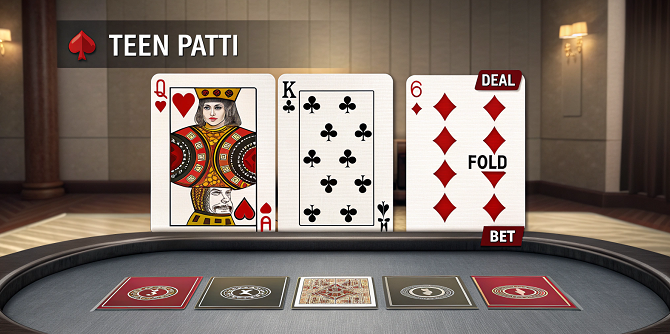Teen Patti Game Explained in Simple Words
Teen Patti, also known as 3 Patti, is a popular Indian card game inspired by Poker. It uses a standard 52-card deck, excluding jokers, and is typically played by 3 to 6 people.
Each player gets three cards. The goal is to have the highest-ranking hand or make others fold by betting. Moves include seen, blind, side-show, and pack. All bets go into the pot, and the winner takes it.
Both offline and online versions exist. Real cash play is available in apps that support Paytm, UPI, and offer instant withdrawals. Explore the top options in our All Teen Patti game apps collection.
H2 Basic Teen Patti Rules
Understanding how the game works is essential before placing real bets. Every version in All Teen Patti game apps follows the same core rules. Learning them improves gameplay decisions and helps avoid early mistakes. Even small details can affect outcomes.
Number of Players and Cards
Teen Patti is played by 3 to 6 players, though some tables support up to 8. A standard 52-card deck is used. There are no jokers. Each player receives three face-down cards. The goal is to form the highest-ranking hand or outplay others into folding.
Minimum Bet (Boot/Ante)
The boot, or ante, is the minimum amount placed in the pot before cards are dealt. All players must contribute equally. This creates the initial prize pool. Further bets increase the pot as the game progresses.
Dealing and Betting Turns
The dealer shuffles and deals three face-down cards to each player. Action moves clockwise, starting from the seat next to it. Players either fold, call, or raise. The round continues until a showdown or all but one player folds.
Blind vs Seen Play
Blind players bet without looking at their cards. Players can see their cards before acting. A seen player must bet at least double the last blind stake. This maintains a balance between risk and strategy for both playing styles.
Showdown and Sideshow Rules
The additional game allows the player who sees the cards to privately compare them with the cards of the previous player who saw the cards. The one with the lower hand folds. A showdown happens when only two players remain. They reveal their cards, and the stronger hand wins the pot.
Step-by-Step Gameplay
- Choose the Dealer – One player is selected to deal the cards. The role rotates each round.
- Place the Boot – All players contribute a fixed starting amount to the pot. This creates the base prize.
- Deal the Cards – The dealer gives three face-down cards to each player. No jokers are used.
- Player Decisions – Players take turns in a clockwise direction. They can bet, call the last bet, or fold.
- Sideshow Requests – Players who have seen their cards may request a private comparison of their cards with those of the previous player who saw their cards. Players with weaker combinations fold.
- Two-Player Showdown – If two remain, cards are revealed. The stronger hand wins the pot.
- Multiple-Player Showdown – If many are left, one can call for a showdown. All remaining hands are revealed.
Teen Patti Hand Rankings
Knowing the hand rankings is crucial for making informed bets. All Teen Patti game outcomes depend on these combinations. Stronger hands beat weaker ones, even without seeing cards. Below are the ranks, from highest to lowest.
Trail or Three of a Kind
Three cards of the same rank. Example: Q-Q-Q. This is the strongest hand in the game.
Pure Sequence / Straight Flush
Three consecutive cards of the same suit. Example: 5-6-7 of hearts. Beats a standard sequence.
Sequence / Run
Three consecutive cards of any suit. Example: 8-9-10 in mixed suits. Lower than a pure sequence.
Color / Flush
Three cards of the same suit, but not in sequence. Example: 2, 9, J of clubs.
Pair
Two cards of the same rank. The third card (kicker) decides in a tie. Example: K-K-5.
High Card
No combination. The highest card decides the winner. Used when all other hands fail.
| Hand Type | Frequency | Probability |
| Trail (Three of a Kind) | Rare | 0.24% |
| Pure Sequence | Rare | 0.22% |
| Sequence | Low | 3.26% |
| Color | Medium | 4.96% |
| Pair | Common | 16.94% |
| High Card | Most Common | 74.38% |
Betting Structures in Teen Patti
Betting rules shape how many players risk and how big pots can grow. Each format changes how cautious or aggressive the round feels. Responsible betting is encouraged — see gamcare.org.uk for support and resources.
No Limit
Players can bet any amount at any time. There’s no cap on raises or calls.
Fixed Limit
Bets and raises must adhere to established limits. No one can exceed the fixed amount.
Pot Limit
A player may bet only up to the size of the current pot. Stakes grow as the pot grows.
Spread Limit
Each round allows bets within a defined range. Players stay within a set minimum and maximum.
Playing Styles and Strategies
Understanding common play styles can improve decisions during each round. Different approaches change how risks are managed. Some styles aim to confuse opponents, others rely on discipline and timing. Learning these can help increase win potential.
Loose Play
Loose players often bet, even with weak hands. They take risks and create unpredictable situations.
Passive Play
This style avoids raising and waits for strong cards. Players typically fold and rarely apply pressure.
Conservative Play
Only strong hands are played. Weak hands are folded quickly without further investment.
Tight Play
Few hands are played, making actions easy to predict. Still, this style is hard to exploit.
Bluffing
A player bets strongly with weak cards. The goal is to force others to fold.
Aggressive / Calculative Play
Players apply pressure using well-timed bets. Moves are based on math, patterns, and reading the table.







